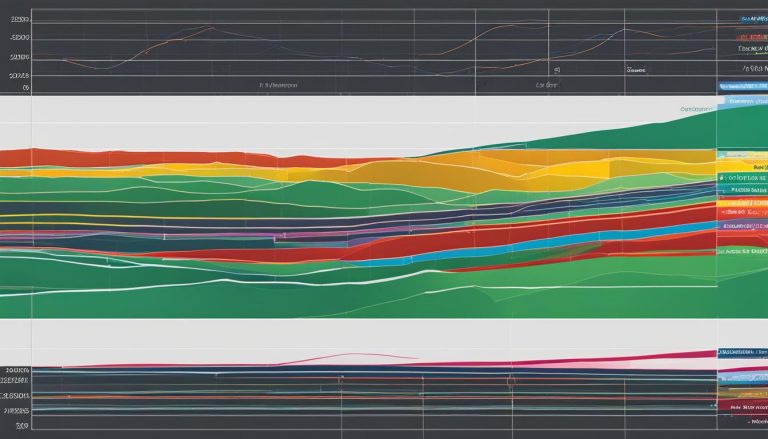Welcome to the world of unsupervised learning! In this article, I will provide you with a comprehensive understanding of what unsupervised learning is, its definition, and how it works. Unsupervised learning is a fascinating branch of machine learning that operates without human supervision. It allows machines to uncover patterns and insights within unlabeled data, making it a powerful tool for data analysis and discovery.
Unsupervised learning algorithms infer their own rules and structure by analyzing similarities, differences, and patterns within the data. Unlike supervised learning, which relies on labeled data to determine patterns, unsupervised learning algorithms explore the data without explicit guidance. This approach is particularly useful for organizing large datasets into clusters, identifying hidden patterns, and categorizing data.
Unsupervised learning has a wide range of applications across various industries. It is used in personalized recommendations, fraud detection, and image analysis, among others. By leveraging unsupervised learning algorithms, businesses can gain valuable insights and make data-driven decisions.
Key Takeaways:
- Unsupervised learning operates without human supervision.
- It uses unlabeled data to discover patterns and insights.
- Unlike supervised learning, unsupervised learning infers its own rules and structure.
- Applications of unsupervised learning include personalized recommendations, fraud detection, and image analysis.
- Unsupervised learning allows businesses to gain valuable insights and make data-driven decisions.
Understanding Unsupervised Learning Algorithms
Unsupervised learning algorithms play a crucial role in making sense of unlabeled data and extracting valuable insights. These algorithms enable machines to uncover hidden patterns and structures that may not be apparent to the human eye. One of the most commonly used techniques in unsupervised learning is clustering, which involves grouping similar data points together based on similarities or differences.
Clustering algorithms come in various forms, including exclusive, overlapping, hierarchical, and probabilistic clustering. Exclusive clustering assigns each data point to a single cluster, while overlapping clustering allows data points to belong to multiple clusters simultaneously. Hierarchical clustering creates a tree-like structure of nested clusters, and probabilistic clustering assigns probabilities to data points belonging to different clusters. These techniques provide flexibility in uncovering different types of patterns and relationships within the data.
Another important unsupervised learning technique is association rule mining. This technique aims to discover correlations and co-occurrences within datasets, enabling us to identify meaningful relationships between different variables. Association rule mining is widely used in market basket analysis, where it helps identify which items are frequently purchased together. By understanding these associations, businesses can optimize their marketing strategies, improve customer experience, and drive sales.
| Unsupervised Learning Technique | Use Case |
|---|---|
| Clustering | Customer segmentation, fraud detection, image analysis |
| Association Rule Mining | Market basket analysis, correlation discovery |
In addition to clustering and association rule mining, unsupervised learning techniques also include dimensionality reduction. This technique is used to reduce the number of irrelevant features in a dataset, making it more manageable and easier to analyze. Popular dimensionality reduction techniques, such as principle component analysis (PCA) and singular value decomposition (SVD), help retain the most important information while discarding redundant or noisy features.
Overall, unsupervised learning algorithms provide powerful tools for uncovering hidden patterns, grouping similar data points, and reducing the complexity of datasets. By leveraging these techniques, businesses can gain valuable insights, enhance decision-making processes, and drive innovation in various domains.
Applications of Unsupervised Learning
Unsupervised learning has become increasingly valuable in a wide range of industries, offering unique applications and benefits. By leveraging unsupervised learning algorithms, businesses can gain valuable insights, optimize processes, and make data-driven decisions. Let’s explore some examples of the applications of unsupervised learning:
Anomaly Detection
One of the key applications of unsupervised learning is anomaly detection. By analyzing unlabeled data, unsupervised learning algorithms can identify unusual patterns or outliers within large datasets. This is particularly useful in fraud detection, where it can help identify suspicious behavior or transactions that deviate from normal patterns.
Recommendation Engines
Unsupervised learning algorithms are also widely used in recommendation engines. By analyzing customer behavior and preferences, these algorithms can group similar customers together, allowing businesses to provide personalized recommendations. This application is commonly seen in e-commerce platforms, streaming services, and online content platforms, where accurate recommendations can significantly improve customer satisfaction and increase revenue.
Customer Segmentation
Customer segmentation is another valuable application of unsupervised learning. By clustering customers based on their purchasing behavior, demographics, or other relevant factors, businesses can identify distinct customer segments. This can help in creating targeted marketing strategies, developing personalized product offerings, and improving customer relationship management.
| Application | Description |
|---|---|
| Anomaly Detection | Identifying unusual patterns or outliers within large datasets, particularly useful in fraud detection. |
| Recommendation Engines | Analyzing customer behavior to provide personalized recommendations, improving customer satisfaction and increasing revenue. |
| Customer Segmentation | Clustering customers based on their behavior to create targeted marketing strategies and improve customer relationship management. |
These are just a few examples of the many applications of unsupervised learning. As technology continues to advance and algorithms become more sophisticated, the potential of unsupervised learning is ever-expanding. By harnessing the power of unsupervised learning, businesses can unlock valuable insights and gain a competitive edge in today’s data-driven world.
Understanding the Difference Between Supervised and Unsupervised Learning
In the field of machine learning, there are two primary approaches: supervised learning and unsupervised learning. While both methods aim to extract insights from data, they differ significantly in their approach and application.
Supervised learning relies on labeled training data, where the target answer is already known. The algorithm learns patterns within the data to make predictions or classify new instances. It follows a feedback mechanism, adjusting its parameters based on the feedback received during training. This type of learning is commonly used in tasks such as spam classification, sentiment analysis, and image recognition.
On the other hand, unsupervised learning operates with unlabeled data, where the target answer is unknown. Instead of relying on predefined labels, unsupervised learning algorithms explore the data to discover patterns and structures on their own. By identifying similarities, differences, and clusters within the data, these algorithms gain insights into the underlying relationships. Unsupervised learning is used for tasks such as data clustering, anomaly detection, and dimensionality reduction.
“Supervised learning relies on labeled data, while unsupervised learning explores unlabeled data to discover patterns and structures.”
The key distinction between these two approaches lies in the feedback mechanism and the availability of labeled data. Supervised learning models have predetermined goals and require labeled data for training, whereas unsupervised learning models explore data without specific targets. This makes unsupervised learning particularly useful when working with large datasets that are unannotated or when the desired outcome is unknown.
The Advantages of Unsupervised Learning
Unsupervised learning offers numerous advantages that make it a valuable tool in the field of machine learning. One of the main benefits is its ability to handle large amounts of unlabeled data. This makes unsupervised learning ideal for processing complex datasets that may not have pre-existing labels. By analyzing and discovering patterns within this unlabeled data, unsupervised learning algorithms can generate valuable insights and uncover previously unknown relationships.
Another advantage of unsupervised learning is its ability to uncover hidden patterns and structures within the data. Unlike supervised learning, which relies on labeled data and predefined structures, unsupervised learning algorithms can detect patterns that may not be readily apparent to human observers. This can lead to new discoveries and insights that can greatly benefit various industries.
Unsupervised learning also has the advantage of being able to handle real-time data streams. This means that it can analyze and adapt to data as it is being generated, allowing for dynamic and up-to-date analysis. This is particularly useful in industries where data is constantly changing and evolving, such as finance or healthcare.
Additionally, unsupervised learning can be used as a preprocessing step to generate labeled data for supervised learning algorithms. By first using unsupervised learning to uncover patterns and structures within the data, it becomes easier to label the data and train supervised learning models. This can save time and resources compared to manually labeling large amounts of data upfront.
| Advantages of Unsupervised Learning |
|---|
| Handling large amounts of unlabeled data |
| Uncovering hidden patterns and structures |
| Handling real-time data streams |
| Generating labeled data for supervised learning algorithms |
Unsupervised Learning Techniques and Use Cases
Unsupervised learning techniques play a crucial role in uncovering patterns and structures within unlabeled data. These techniques offer valuable insights and applications across various industries. Let’s explore some prominent unsupervised learning techniques and their use cases.
Clustering:
Clustering is a widely used unsupervised learning technique that groups similar data points together based on their characteristics. This technique finds applications in customer segmentation, where businesses can identify distinct customer groups and tailor their marketing strategies accordingly. Clustering is also employed in fraud detection, where anomalous patterns can be identified by analyzing clusters of normal behavior. Additionally, clustering is utilized in image analysis for tasks like object recognition and image compression.
Association Rule Mining:
Association rule mining involves discovering relationships and patterns within datasets. This technique has applications in market basket analysis, where associations between different items in a customer’s basket are identified. By analyzing these associations, businesses can gain insights into purchasing behavior and optimize product placement and recommendations. Association rule mining also plays a crucial role in recommendation engines, enabling personalized suggestions based on user preferences and browsing patterns.
Dimensionality Reduction:
Dimensionality reduction techniques are used to simplify complex datasets by reducing the number of features while retaining the important information. This technique is commonly applied in tasks like image compression, where high-dimensional image data is transformed into a lower-dimensional representation. Dimensionality reduction also helps in removing noise and irrelevant features from datasets, enabling more efficient analysis and modeling. By reducing the dimensionality of data, businesses can speed up processing time and improve the performance of machine learning algorithms.
| Use Case | Industry |
|---|---|
| Risk Assessment | Finance |
| Anomaly Detection | Cybersecurity |
| Recommendation Engines | E-commerce |
| Natural Language Processing | Technology |
| Genetic Research | Healthcare |
| Delivery Store Optimization | Retail |
In addition to the above techniques, unsupervised learning finds applications in risk assessment, anomaly detection, recommendation engines, Natural Language Processing, genetic research, and delivery store optimization. These use cases highlight the versatility and broad impact of unsupervised learning in various industries.
Exploring the World of Unsupervised Learning
Unsupervised learning is a fascinating realm of machine learning that allows us to delve into the depths of unlabeled data and uncover hidden insights and patterns. By leveraging unsupervised learning algorithms, we can explore and discover knowledge and connections that may not be immediately apparent to the human eye. The applications of unsupervised learning are vast and diverse, spanning across industries such as finance, healthcare, retail, and more.
One of the key advantages of unsupervised learning is its ability to handle large amounts of unlabeled data. This makes it particularly suitable for processing complex datasets that would be challenging to label manually. Unsupervised learning can also uncover previously unknown patterns and relationships within the data, leading to new discoveries and insights. Moreover, it can adapt to real-time data streams, enabling dynamic analysis and decision-making.
Applications of unsupervised learning are constantly expanding as technology advances. In finance, unsupervised learning can be applied to risk assessment and anomaly detection to help identify potentially fraudulent activities. In healthcare, unsupervised learning is used to analyze patient data and improve medical diagnoses. Retail businesses leverage unsupervised learning for customer segmentation and personalized recommendations. These are just a few examples of how unsupervised learning is revolutionizing industries and enabling data-driven decision-making.
Unsupervised learning opens up a world of possibilities for exploration and discovery. By embracing this powerful branch of machine learning, businesses can gain valuable insights, optimize processes, and make informed decisions. As technology continues to advance, the potential of unsupervised learning will only continue to grow, offering endless opportunities for uncovering hidden knowledge and harnessing the power of data.
| Industry | Application |
|---|---|
| Finance | Risk assessment, fraud detection |
| Healthcare | Medical diagnosis, patient data analysis |
| Retail | Customer segmentation, personalized recommendations |
Conclusion
Unsupervised learning is a powerful branch of machine learning that allows machines to learn from unlabeled data and uncover patterns and structures on their own. By using algorithms that infer their own rules and structure based on similarities, differences, and patterns within the data, unsupervised learning can organize large datasets into clusters, identify previously undetected patterns, and categorize data.
The applications of unsupervised learning are vast and continue to expand as technology advances. From customer segmentation and anomaly detection to recommendation engines and fraud detection, unsupervised learning offers valuable insights and optimization opportunities in various industries. It has proven to be a valuable tool in fields such as finance, healthcare, and retail.
Understanding the difference between supervised and unsupervised learning is crucial for fully harnessing the potential of machine learning. While supervised learning relies on labeled training data with predetermined goals, unsupervised learning explores data without specific targets, allowing for exploration and discovery. As technology continues to advance, the possibilities of unsupervised learning are limitless, offering new opportunities for businesses to make data-driven decisions and gain a competitive edge.
FAQ
What is unsupervised learning?
Unsupervised learning is a type of machine learning that operates without human supervision, using unlabeled data to discover patterns and insights.
How does unsupervised learning work?
Unsupervised learning algorithms infer their own rules and structure based on similarities, differences, and patterns within the data, organizing large datasets into clusters and categorizing data.
What are unsupervised learning algorithms used for?
Unsupervised learning algorithms are used to process unlabeled data, uncover patterns and structures, perform clustering, association rule mining, and dimensionality reduction.
What are the applications of unsupervised learning?
Unsupervised learning has applications in personalized recommendations, fraud detection, customer segmentation, text classification, genetic research, and image analysis.
What is the difference between supervised and unsupervised learning?
Supervised learning relies on labeled data and has a feedback mechanism, while unsupervised learning uses unlabeled data and does not have a feedback mechanism.
What are the advantages of unsupervised learning?
Unsupervised learning can handle large amounts of unlabeled data, uncover unknown patterns, handle real-time data streams, and be used as a preprocessing step for supervised learning algorithms.
What are some unsupervised learning techniques and use cases?
Unsupervised learning techniques include clustering, association rule mining, and dimensionality reduction, with use cases ranging from customer segmentation to image compression.
What is the essence of unsupervised learning?
Unsupervised learning focuses on exploration and discovery within unlabeled data, uncovering hidden insights and patterns for analysis and decision-making.
Cathy is a senior blogger and editor in chief at text-center.com.


